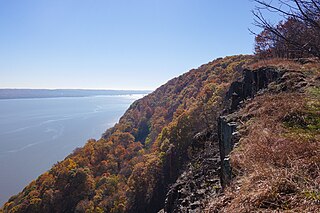
Rockland County is the southernmost county on the west side of the Hudson River in the U.S. state of New York. It is part of the New York metropolitan area. As of the 2020 U.S. census, the county's population is 338,329, making it the state's third-most densely populated county outside New York City after Nassau and neighboring Westchester Counties. The county seat and largest city is New City. Rockland County is accessible via the New York State Thruway, which crosses the Hudson to Westchester at the Tappan Zee Bridge ten exits up from the NYC border, as well as the Palisades Parkway five exits up from the George Washington Bridge. The county's name derives from "rocky land", as the area has been aptly described, largely due to the Hudson River Palisades.
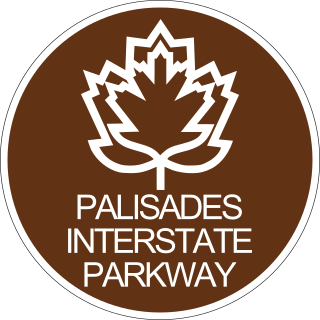
The Palisades Interstate Parkway (PIP) is a 38.25-mile-long (61.56 km) controlled-access parkway in the U.S. states of New Jersey and New York. The parkway is a major commuter route into New York City from Rockland and Orange counties in New York and Bergen County in New Jersey. The southern terminus of the route is at the George Washington Bridge in Fort Lee, New Jersey, where it connects to Interstate 95 (I-95), New Jersey Route 4, U.S. 1, U.S. 9, and US 46. Its northern terminus is at a traffic circle in Fort Montgomery, New York, where the PIP meets US 9W and US 202 at the Bear Mountain Bridge. At exit 18, the PIP forms a concurrency with US 6 for the remaining duration of its run.
Bear Mountain State Park is a 5,205-acre (21.06 km2) state park located on the west bank of the Hudson River in Rockland and Orange counties, New York. The park offers biking, hiking, boating, picnicking, swimming, cross-country skiing, cross-country running, sledding and ice skating. It also includes several facilities such as the Perkins Memorial Tower, the Trailside Museum and Zoo, the Bear Mountain Inn, a merry-go-round, pool, and a skating rink. It also hosts the Bear Mountain Circle, where the historic Palisades Interstate Parkway and Bear Mountain Bridge meet. It is managed by the Palisades Interstate Park Commission, which is overseen by the State of New York.
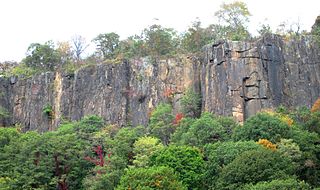
The Palisades, also called the New Jersey Palisades or the Hudson River Palisades, are a line of steep cliffs along the west side of the lower Hudson River in Northeastern New Jersey and Southeastern New York in the United States. The cliffs stretch north from Jersey City about 20 miles (32 km) to near Nyack, New York, and are visible at Haverstraw, New York. They rise nearly vertically from near the edge of the river, and are about 300 feet (90 m) high at Weehawken, increasing gradually to 540 feet (160 m) high near their northern terminus. North of Fort Lee, the Palisades are part of Palisades Interstate Park and are a National Natural Landmark.
At 47,527 acres (192.33 km2), Harriman State Park is the second largest state park in the U.S. state of New York. Located in Rockland and Orange counties 30 miles (48 km) north of New York City, it is a haven for hikers with over 200 miles (320 km) of hiking trails. The park is also known for its 31 lakes, multiple streams, public camping area, and great vistas. The park's hiking trails are currently maintained by volunteers from the New York - New Jersey Trail Conference.

Tallman Mountain State Park is a 687-acre (2.78 km2) state park in Rockland County, New York, located adjacent to the Hudson River in the Town of Orangetown just south of Piermont. It is part of the Palisades Interstate Park System.
Major William Addams Welch was an American engineer and environmentalist who would have a major impact on the state and national park systems of the United States. Born in Cynthiana, Kentucky, he obtained a civil engineering degree from Colorado College in 1882 and a master's degree from the University of Virginia in 1886.

Raymond Hezekiah Torrey was the author of weekly columns, Outings and The Long Brown Path in the New York Evening Post in the 1920s and 1930s. The column played a major role in the development of the 2,100-mile (3,400 km) Appalachian Trail, the Long Path and the popularity of hiking generally. He was a founding member of the New York–New Jersey Trail Conference and one of the authors of the first edition of the New York Walk Book. He had extensive scientific knowledge, writing about everything from the short-billed marsh wren to marine fossils and lichens; he could identify over 700 plants. He was secretary of the Association for the Preservation of the Adirondacks, and also secretary of the American Scenic and Historic Preservation Society.

Nyack Beach State Park is a 61-acre (0.25 km2) state park in Upper Nyack, Rockland County, New York. It consists of a small parking lot and a riverfront pathway, the southernmost section of the Hudson River Valley Greenway. It is known for its physical proximity to the Hudson River on one side of the pathway and the looming cliffs of the Palisades rising 700 feet (210 m) above on the other side.

Doodletown was an isolated hamlet in the Town of Stony Point, Rockland County, New York, United States. Purchased by the Palisades Interstate Park Commission during the 1960s, it is now part of Bear Mountain State Park and a popular destination for hikers, birdwatchers, botanists, and local historians. It is located north of Jones Point, west of Iona Island, and southeast of Orange County. The former settlement is now a ghost town.

County Route 106 (CR 106) is a 7.8-mile (12.6 km) east–west county route in Rockland County, New York, in the United States. It serves as an eastward continuation of Kanawauke Road, extending from the Orange County line to U.S. Route 9W (US 9W) and US 202 in Stony Point via Harriman State Park. CR 106 intersects with several county highways in Rockland County along the way. The route was only one of two in Rockland County to keep its numbering from Orange County, with the other being CR 72. CR 106 had one spur route, CR 106A, which was recently decommissioned.
Seven Lakes Drive is a north–south parkway located in the Hudson Valley region of New York in the United States. It extends for just under 18 miles (29 km) on a northeast–southwest alignment from an intersection with New York State Route 17 (NY 17) in the village of Sloatsburg to a junction with U.S. Route 9W (US 9W) and US 202 south of the Bear Mountain Bridge in the town of Stony Point. Most of the parkway is located in either Harriman or Bear Mountain state parks, except for a small stretch near its western end. Ownership of Seven Lakes Drive is split between three entities, two of which are also responsible for maintenance of the road.
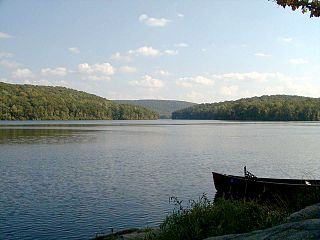
At 310 acres (1.3 km2), Lake Sebago, near Sloatsburg, is the largest lake in Harriman State Park in the U.S. state of New York. The name is Algonquian for "big water". It is located just south of Lake Kanawauke and is accessible via Seven Lakes Drive and the Palisades Interstate Parkway. New Sebago Beach opened in the 1940s but closed in 2011 due to damage from Hurricane Irene, and the picnic areas closed in 2012 due to Hurricane Sandy.
Arden Valley Road is a scenic road located in Southfields, New York, in the United States, that travels through Harriman State Park and is owned by the Palisades Interstate Park Commission. At 5.2 miles (8.4 km) long, it begins at New York State Route 17 (NY 17) in Southfields and ends at Seven Lakes Drive in Harriman State Park. Arden Valley Road also serves a trout stocking area for the Ramapo River. The road is located entirely in Orange County and is home to the Elk's Pen Trailhead in Harriman State Park. In 1921, plans arose by the commission to construct the road, which was completed the same year and stretched along the borderline with the Harriman estate. Major William A. Welch ordered 75 elk from Yellowstone National Park to be placed in a wired cage between Arden and Southfields in 1919. The elk eventually disappeared from the pen by 1942, and the area became the current Elk's Pen trailhead for trails within Harriman State Park.
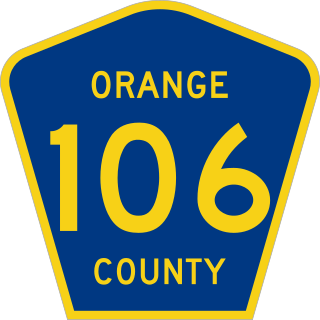
County Route 106 (CR 106) in the county of Orange County, New York, was a continuation of two routes, New York State Route 17A (NY 17A) at its western terminus and Rockland CR 106 at the eastern terminus. Route 106 began at an intersection with NY 17A and its parent route, NY 17 in Southfields, where CR 106 signs are still posted according to the August 2018 Google Street View images. The route went eastward through Harriman State Park, crossing Seven Lakes Drive before entering nearby Rockland County, New York. There it became Rockland County Route 106 and heads all the way to Stony Point.
Sandyfield was a settlement of about 30 houses in the Town of Ramapo in Rockland County, New York, United States, that was submerged in 1928 when swampy Beaver Pond was dammed to create Lake Welch in Harriman State Park.
Lake Welch Parkway, sometimes labeled Lake Welch Drive, is a scenic road located within Harriman State Park in southern New York in the United States. It extends for 5.60 miles (9.01 km) on a southwest–northeast alignment from an intersection with Seven Lakes Drive to a partial interchange with the Palisades Interstate Parkway. The highway is located entirely in Rockland County, although it runs close to the border with Orange County. It is inventoried by the New York State Department of Transportation as New York State Route 987A, an unsigned reference route; however, it is owned by the Palisades Interstate Park Commission. The portion of Lake Welch Parkway that lies south of Tiorati Brook Road is closed during the winter. The parkway is the main route to access all beaches in Harriman State Park: Lake Welch, Lake Tiorati, and Lake Sebago.
Tiorati Brook Road is a scenic road located within Harriman State Park in southern New York in the United States. The highway extends for 3.6 miles (5.8 km) between Tiorati Circle, a traffic circle connecting Tiorati Brook Road to Seven Lakes Drive in Orange County, and an interchange with Lake Welch Parkway just west of where that parkway ends at Palisades Interstate Parkway in Rockland County. The road crosses over the county line roughly midway between the two locations. Tiorati Brook Road is owned and maintained by the Palisades Interstate Park Commission.

Hook Mountain State Park is a 676-acre (2.74 km2) undeveloped state park located in Rockland County, New York. The park includes a portion of the Hudson River Palisades on the western shore of the Hudson River, and is part of the Palisades Interstate Park system. Hook Mountain State Park is functionally part of a continuous complex of parks that also includes Rockland Lake State Park, Nyack Beach State Park, and Haverstraw Beach State Park.
Haverstraw Beach State Park is a 73-acre (0.30 km2) state park located in the Haverstraw, New York. The park is included within the Palisades Interstate Park system and is functionally part of a continuous complex of parks that also includes Rockland Lake State Park, Hook Mountain State Park, and Nyack Beach State Park.












